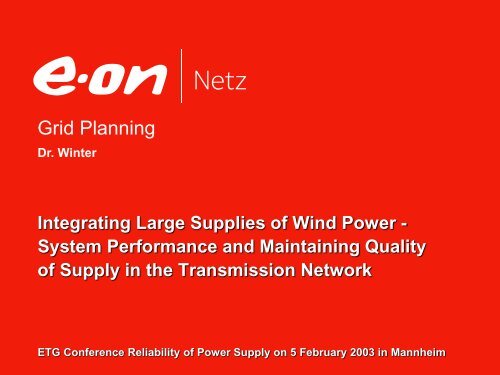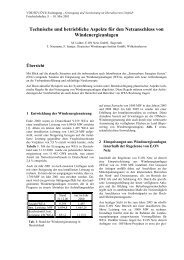Dr. Winter
Dr. Winter
Dr. Winter
Create successful ePaper yourself
Turn your PDF publications into a flip-book with our unique Google optimized e-Paper software.
Grid Planning<strong>Dr</strong>. <strong>Winter</strong>Integrating Large Supplies of Wind Power -System Performance and Maintaining Qualityof Supply in the Transmission NetworkETG Conference Reliability of Power Supply on 5 February 2003 in Mannheim
Installed wind power capacity in EuropeTotal: 18,578 MW(As per July 2002)Others 2.2%407 MWSweden 1.5%280 MWIreland 0.7%125 MWPortugal 0.7%127 MWGreece 1.5%272 MWGreat Britain 2.7%498 MWNetherlands 2.7%501 MWItaly 3.8%700 MWDenmark 13.2%2,456 MWSpain 19.9%3,712 MWQuelle: “Windpower Monthly“Germany 51.1%9,500 MWETG Conference Reliability of Power Supply 5 February 2003 Page 2<strong>Dr</strong>. <strong>Winter</strong> – Grid Planning
Installed Capacity in MWDevelopment of Wind Power in Germany50,00045,00040,00035,000Onshore and Offshore30,00025,00020,00015,00010,000OnshoreOnshore in the E.ON Netz control area5,00001990 1995 2000 2005 2010 2015 2020 2025 2030YearETG Conference Reliability of Power Supply 5 February 2003 Page 3<strong>Dr</strong>. <strong>Winter</strong> – Grid Planning
System engineering criteria for limiting wind power supplyThermal limitsVoltage stabilityFrequency stabilityETG Conference Reliability of Power Supply 5 February 2003 Page 4<strong>Dr</strong>. <strong>Winter</strong> – Grid Planning
Thermal limitsStructurally weakregions in the northof the control areaSetting up of new routesETG Conference Reliability of Power Supply 5 February 2003 Page 5<strong>Dr</strong>. <strong>Winter</strong> – Grid Planning
Thermal limitsGrid upgrading and grid connection requirementsWind power development + grid upgrading for E.ON NetzMW18,00014,00010,000Installed windcapacityAdditionalroute kilometres300 700 1,000Accumulatedadditional routekilometres110 and 380 kVin km1,0008006006,0004002,0002002001 2006 2011 2016Cost€110 million €400 million €550 millionSource: IAEW RWTH Aachen 2002ETG Conference Reliability of Power Supply 5 February 2003 Page 6<strong>Dr</strong>. <strong>Winter</strong> – Grid Planning
Capacity MWSystem control / Frequency stabilityWind power supply in the E.ON Netz control area300028002600240022002000180016001400120010008006004002000Mon Tue Wed Thu Fri Sat Sun2,400 MW active power decrease in 24 hours300028002600240022002000180016001400120010008006004002000Weekly rate from28.05.2001ETG Conference Reliability of Power Supply 5 February 2003 Page 7<strong>Dr</strong>. <strong>Winter</strong> – Grid Planning
MW18,00014,0002,3004,200Frequency stability8,000System control requirementsForecast wind development and average control requirementfor E.ON Netz10,000Installed windcapacityControlling powerrange needed10,0006,0002,0002001 2006 2011 2016Source: IAEW RWTH Aachen 2002ETG Conference Reliability of Power Supply 5 February 2003 Page 8<strong>Dr</strong>. <strong>Winter</strong> – Grid Planning
Frequency stabilityVoltage profile after a three-phase fault as per 2002 Failure of the entireWEC supplyETG Conference Reliability of Power Supply 5 February 2003 Page 9<strong>Dr</strong>. <strong>Winter</strong> – Grid Planning
Frequency stabilityVoltage levels when a wind farm is integrated into the 110 kV grid110 kV 20 kV0.69 kV1 2 3S1S2ASG3~As per December 2002: When the terminal voltage is 80% of thenominal system voltage, the wind energy converters aredisconnected from the grid for an indefinite period.ETG Conference Reliability of Power Supply 5 February 2003 Page 10<strong>Dr</strong>. <strong>Winter</strong> – Grid Planning
Frequency stabilitySystem voltage waveshape during and after system faultsU N [pu]1,11,00,90,80,70,60,51.25 1.50 1.75 2.00 2.25 2.50 2.75 3.00 3.25 3.50 3.75t/sSystem voltage at the connecting point (110 kV)System voltage on the main bus bar in the wind farm (20 kV)System voltage at the wind generator (0.7 kV)System voltage at the wind generator (0.7 kV), voltage controlETG Conference Reliability of Power Supply 5 February 2003 Page 11<strong>Dr</strong>. <strong>Winter</strong> – Grid Planning
Frequency stabilityFailure of wind power supply after a three-phase fault in the380 kV grid near Dollern substationWind distribution in the E.ON Netz control area in Dec. 2002Hanover area Ems-Elbe Weser-Ems Schleswig-Holstein850 MW 500 MW 1,350 MW 2,300 MWScenario2001ScenarioDec. 2002ScenarioDec. 2005Observation point Failure capacity Inst. wind capacitySystem connectingpointGeneratorterminalsMachineterminals2,700 MW2,880 MW< 3,000 MW3,000 MW5,000 MWNew connecting regulations for WECs in force as of 20037,500 MWETG Conference Reliability of Power Supply 5 February 2003 Page 12<strong>Dr</strong>. <strong>Winter</strong> – Grid Planning
Frequency stabilityAction taken in the event of a fault in order to reduce the areaaffected and the power loss• No automatic disconnection of wind farmsabove the red characteristic curveAim: reduction of the area affected by the failure and the loss ofwind power when a fault occurs (< 3,000 MW)ETG Conference Reliability of Power Supply 5 February 2003 Page 13<strong>Dr</strong>. <strong>Winter</strong> – Grid Planning
Voltage stabilityASG3~Wind energy converter (WEC) with an asynchronous generator• High-speed asynchronous generator• Gearbox• Reactive-power compensation by means of condensers• Non-variable rotor speed• Reactive power only adjustable in steps• No voltage control / cos phi control• Short-term reactions after fault rectificationSG3~WEC with synchronous generator• Low-speed synchronous generator witha large number of pole pairs• No gearbox• Variable rotor speed• Pulse-controlled inverter (var. P/Q)• Voltage control / cos phi control• No reactionsASG3~WEC with double-fed induction generator• High-speed asynchronous generator• Gearbox• Variable rotor speed• Fully adjustable reactive power• Voltage control / cos phi control• Reactions after fault rectification lasting more than 15 seconds• Reactions when control is switched on after system faultsETG Conference Reliability of Power Supply 5 February 2003 Page 14<strong>Dr</strong>. <strong>Winter</strong> – Grid Planning
Voltage stabilityInduction generator WEC performance during a system faultU/UnL1L2L3I/[MVA]L1L2L3P/[MW]Q/[Mvar]10-1100-10100n [1/min]-101800170016000.00 0.25 0.50 0.75 t [sec]1.00ETG Conference Reliability of Power Supply 5 February 2003 Page 15<strong>Dr</strong>. <strong>Winter</strong> – Grid Planning
Voltage stabilityDFIG WEC performance during a system faultU/UnL1L2L3I [MVA]L1L2L3P/[MW]Q/[Mvar]10-150-550-5Control OFF0.00 0.25 0.50 0.75 1.00t [sec]ETG Conference Reliability of Power Supply 5 February 2003 Page 16<strong>Dr</strong>. <strong>Winter</strong> – Grid Planning
Voltage stabilityUCTE/CENTREL model - installed wind capacity: 5,000 MWSystem voltages after a 3-phase fault at Dollern substation – fault remedied after 150 msUnterweser380 kVDeviation of the system voltage from the nominal system voltage in %-50%Krümmel380 kV-50%Conneforde220 kV-50%SottrumEms Elbe110 kVOldenburgWeser Ems110 kV-50%-50%Hamburg NordSchleswig-Holstein110 kV-50%0.00 0.25 0.50 0.75 1.00t [sec]Voltage dip caused by the phase effects of wind farms, control of which ceasesin the event of a fault brought about by high rotor currents (around 75% of rated voltage)ETG Conference Reliability of Power Supply 5 February 2003 Page 17<strong>Dr</strong>. <strong>Winter</strong> – Grid Planning
Voltage stabilityFault occursFault rectifiedDisconnection of wind farmsincompatible with the systemt [msec]0 100 200 300 400 500 600 700 800Trip of theunder-voltageprotection0100 200 300 400 500Time to disconnection of the wind farmt [msec]100%90%80%70%60%50%0.00 0.25 0.50 0.75 1.00t [sec]No selective disconnection of wind farms incompatible with the systemSelective disconnection of wind farms incompatible with the systemWind farms switch from cos control to voltage control during system faultsETG Conference Reliability of Power Supply 5 February 2003 Page 18<strong>Dr</strong>. <strong>Winter</strong> – Grid Planning
Requirements of the dynamic performance of wind energyconverters in the transmission networkSwitch from cos control to voltage control in the event of voltagedips greater than 10 %Reactive power intake may only exceed 25% of the nominal reactivepower of the wind farm during transient balancing time (about 400 ms)Or optionallySelective cut-off of wind generators incompatible with the system- Synchronisation within 2 seconds of the fault being rectified- Increase in power with a gradient of 10% rated power per second- The failure of a wind farm must not last longer than 12 secondsETG Conference Reliability of Power Supply 5 February 2003 Page 19<strong>Dr</strong>. <strong>Winter</strong> – Grid Planning
Failure of wind energy converters during a 3-phasesystem fault at Dollern substation – long-term failureGrid connection regulations for WECs up to 31 December 2002:Complete cut-off of all generators if thegenerator terminal voltage drops belowObservation point80% of nominal voltage.F [Hz]Scenario2002GeneratorterminalsPower loss2,880 MW50 Hz49.8 Hz49.6 Hz49.4 Hz49.2 Hz49.0 Hz5000P [MW]0 5 10 15 20t[sec]ETG Conference Reliability of Power Supply 5 February 2003 Page 20<strong>Dr</strong>. <strong>Winter</strong> – Grid Planning
WEC failures during a 3-phase system fault at Dollernsubstation – short-term loss of 3,000 MWChange in WEC performance throughre-powering – including generatorsthat are already connectedF [Hz]Scenario2005Observation pointGeneratorterminalsPower loss3,000 MW50 Hz49.8 Hz49.6 Hz49.4 Hz49.2 Hz49.0 Hz5000P [MW]0 5 10 15 20t[sec]ETG Conference Reliability of Power Supply 5 February 2003 Page 21<strong>Dr</strong>. <strong>Winter</strong> – Grid Planning
Summary There will be further growth in onshore and offshore wind power Integration of wind power requires a restructuring of thetransmission networks plus additional extensive power stationreserve capacity No exceeding of the technical limits of the overall system(optimisation of the overall system performance) A joint, coordinated approach involving project planners,producers of wind energy converters and systems technology,network operators, licensing authorities and/or politiciansis required Additional burdens on the network operators must be fairlydistributed (nationwide and throughout Europe) andnot shouldered by individual companiesETG Conference Reliability of Power Supply 5 February 2003 Page 22<strong>Dr</strong>. <strong>Winter</strong> – Grid Planning





